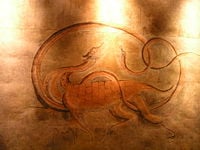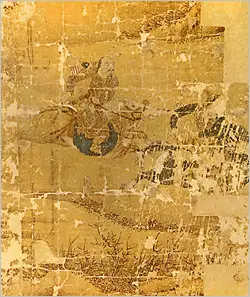Sinsi
Shinshi, a semi-legendary ancient city that, according to the history books such as Samguk Yusa, Gyuwon Sahwa, Shindan Minsa, and Hwandan-gogi, Shinshi or Baedal (Hangul : 배달국 Hanja/Hanzi:倍達國) Hwanung or Dangun established as the firstKorean nation. Shinshi (신시, 神市) literally means "the city of god(s)/spirit(s)" where people live together in a protected area or "the fair/market of god(s)/spirit(s)" where people come together and exchange their goods.
Shinshi (or Sinsi) holds a special place in the minds of Koreans North and South. South Korea tends to emphasize the founding of Korea with the unification of the Three Kingdoms, which included the southern areas of Goguryeo in the north. Still, South Koreans normally grant that Korea's mythical beginnings lay with Hwanung or Dangun founding the mythical city of Sinsi around the year 2333 B.C.E. China rejects the claim that Korea began with Sinsi and Gojoseon since the place of that founding lay deep within China's sovereign terrority today.
Founding of Shinshi State
Records describe the founding of Shinshi State in somewhat different ways. Hwandan-Gogi records that Shinshi state had been founded at the area of Baekdu Mountain and Amur River to provide maximum protection and benefit to the people with the capital city named Shinshi. The legend states that Hwanin (환인,桓因) gave three presents of Cheon Boo and Ihn to Hwanung (환웅,桓雄), and 3,000 people had descended from heaven with Hwanwoong to the area of birch trees—Gyuwon Sahwa records Hwanung Shinshi as the same person. Shinshi state's, also known as Guri, borders reached the Shandong Peninsula in modern-day China. Emperor Chi-Woo the Great of Baedalguk, the greatest and most renowned of the Shishi state's Emperors has been described as a brilliant military leader and strategist. During the time of Emperor Chi-Woo the empire reached its greatest extent. The Shinshi state most likely disintegrated due to internal struggles, and probably fell to neighboring nations.
Government Structure
Three imperial families, Sinsi, Gosi, and Chiwoo, ruled in Shinshi state. The three families ruled as royal families and emperor in the Shinshi state alternatively. The descendants of those three families divided into nine tirbes, the so-called Kuhwan (Gu means nine in Korean). Kuhwan means the nine tribes from Hwanguk, a legendary nation of Korea. The word of Kuhwan sometimes transliterates into other words such as Kuryeo(구려,九黎), Kuyi(구이,九夷), and Koryeo (고려,高黎 or 高麗). Korea derives from Kuryeo and Koryeo.
Poongbaek, Woosa, and Woonsa constitute three representatives of Shinshi state. Five Ministers managed the state; Wooga managed agriculture, Maga managed the life of people, Guga managed a penalty, Jeoga managed disease, and Yangga managed good and evil. The designations of Five Ministers derived from animal names, serving as designation names of Ministers in Gojoseon and Buyeo.
Legacy
Some scholars believe that Gojoseon succeeded the Shinshi state. As mentioned earlier, Shinshi also went by the name Guri, and the word "Goguryeo" can be broken down into Go-Guri, meaning Go (high), Guri. Thus, Goguryoe means "the Higher Guri nation." In addition, Goguryeo also interprets as the nation of Guri or Goryeo governed by the family of "Go" since the family name "Go" makes up Goguryeo. Indeed, the Samguk Sagi states that Goguryoe recovered most of the lost territories previously lost.
War with Huangdi Xuanyuan
When Chiwoo became emperor, Yoomang (楡罔), a descendant of Shennong, ruled as king in the nation of Shennong. At that time, the nation of Shennong became powerful with a massive population for the time. Emperor Chiwoo planned to attack the nation of Shennong, preparing bows, arrows, spears and swords. Emperor Chiwoo amassed troops with nine generals and eighty one adjunct generals in Takrok(涿鹿), conquering the forces of Yoomang at Kuhon(九渾). Emperor Xuanyuan, hearing that emperor Chiwoo governed Shennong, assembled his troops, fighting more than seventy battles with emperor Chiwoo over during a ten–year war. Emperor Chiwoo defeated the emperor Xuanyuan, winning every battle in the war.
Fall of the empire
As with all empires in history, the Shinshi state fell. The steady decay of the ancient empire began after its golden age under its fourteenth ruler, Emperor Chi-Woo the Great of Baedalguk. Korean historians lack records on the causes of the fall of the empire, but many have inferred that corruption and border conflicts with neighboring barbaric tribes caused the fall. Emperor Geobuldan, the eighteenth and final ruler of the Shinshi state, ruled for a mere 48 years while a majority of his predecessors had been recorded to have ruled for over 50 years. Historians have also inferred that the last emperor of Shinshi state sat as a weak puppet monarch, much like other final rulers of other dynasties. Shinshi state followed the same cycle of rise, height and fall as Unified Silla, Goguryeo, Goryeo, and Joseon. Emperor Chook Da-Li of Baedalguk, the sixteenth ruler of Shinshi state reigned as the last emperor to rule over during Shinshi states golden age.
Description about Shinshi in Historical Records
- Hwanung with a group of 3,000 people came down to the shindansu (a kind of sacred tree) and Hwanung taught the people how to live as a human. Hwanung named the place shinshi.
- Gyuwon Sahwa
- Shinshi or Hwanung ruled a nation succeeded by Gojoseon. He made the manners and cultures of marriage, In addition, he ordered the people to engage in farming and exchange their necessities. Chiwoo, Goshi and Shinshi became the rulers of the nation in turn. The nation continued about 11,000 years, and then Dangun founded Gojoseon which is the first state of Korean.
- Shindan Minsa
- Shinshi, the era before Baedal-guk era, lasted about 120 years. Baedal-guk era, the same as Gojoseon, ruled by Dangun, lasting over 1,000 years.
- Budoji
- After Dangun established Gojoseon, the six tribes opened the Shinshi, a kind of feast in which they saluted the sky and sang together in the forest every ten years. They opened the choshi (朝市), the market for visiting and the haeshi (海市), the market facing the sea.
- Hwandan Gogi
- Shinshi state (BC 3898 ∼ BC 2333) was established by Hwanung or Geo Bahl Hwan, [1].
Rulers
There is a list of Shinshi in Hwandan Gogi, as follows.
- Geo Bahl Hwan (Hangul : 거발환 Hanja/Hanzi: 居發桓) (3898 B.C.E.-3804 B.C.E.) died when he was 120.
- Geo Bool Li (Hangul : 거불리 Hanja/Hanzi: 居佛理) (3804 B.C.E.-3718 B.C.E.) died when he was 102.
- Woo Ya Go (Hangul : 우야고 Hanja/Hanzi: 右耶古) (3718 B.C.E.-3619 B.C.E.) died when he was 135.
- Mo Sa Ra (Hangul : 모사라 Hanja/Hanzi: 慕士羅) (3619 B.C.E.-3512 B.C.E.) died when he was 129.
- Tae Woo Eui (Hangul : 태우의 Hanja/Hanzi: 太虞儀) (3512 B.C.E.-3419 B.C.E.) died when he was 115.
- Da Eui Bahl (Hangul : 다의발 Hanja/Hanzi: 多儀發) (3419 B.C.E.-3321 B.C.E.) died when he was 110.
- Geo Ryun (Hangul : 거 련 Hanja/Hanzi: 居連) (3321 B.C.E.-3240 B.C.E.) died when he was 140.
- Ahn Boo Ryun (Hangul : 안부련 Hanja/Hanzi: 安夫連) (3240 B.C.E.-3167 B.C.E.) died when he was 94.
- Yang Woon (Hangul : 양 운 Hanja/Hanzi: 養雲) (3167 B.C.E.-3071 B.C.E.) died when he was 139.
- Gahl Go (Hangul : 갈 고 Hanja/Hanzi: 葛古) (3071 B.C.E.-2971 B.C.E.) died when he was 125.
- Geo Ya Bahl (Hangul : 거야발 Hanja/Hanzi: 居耶發) (2971 B.C.E.-2879 B.C.E.) died when he was 149.
- Joo Moo Shin (Hangul : 주무신 Hanja/Hanzi: 州武愼) (2879 B.C.E.-2774 B.C.E.) died when he was 123.
- Sa Wa Ra (Hangul : 사와라 Hanja/Hanzi: 斯瓦羅) (2774 B.C.E.-2707 B.C.E.) died when he was 100.
- Ja O Ji (Emperor Chi-Woo the Great of Baedalguk) (Hangul : 자오지 Hanja/Hanzi: 慈烏支) - 일명 치우천왕 (2707 B.C.E.-2598 B.C.E.) died when he was 151.
- Chi Aek Teuk (Hangul : 치액특 Hanja/Hanzi: 蚩額特) (2598 B.C.E.-2509 B.C.E.) died when he was 118.
- Chook Da Li (Hangul : 축다리 Hanja/Hanzi: 祝多利) (2509 B.C.E.-2453 B.C.E.) died when he was 99.
- Hyuk Dah Sae (Hangul : 혁다세 Hanja/Hanzi: 赫多世) (2453 B.C.E.-2381 B.C.E.) died when he was 97.
- Guh Bool Dahn (Hangul : 거불단 Hanja/Hanzi: 居弗檀)- 일명 단웅(檀雄) (2381 B.C.E.-2333 B.C.E.) died when he was 82.
See also
- Founding myth of Korea
- Gyuwon Sahwa
- Hwandan-gogi
- Samguk Yusa
ReferencesISBN links support NWE through referral fees
- Chang, Tong-gyun. 2004. Sinsi pontʻogi: pada ro sarajin Pʻyŏngyangsŏng ŭi chŏngchʻe. Pusan-si: Asadal. ISBN 9788995354506
- Kim, Chong-sŏ. 2004. Sinhwa ro nalcho toeŏ on Sinsi, Tanʼgun Chosŏnsa yonʼgu. Sŏul: Hanʼgukhak Yŏnʼguwŏn. ISBN 9788989745099
- Yi, Kang-sik. 1988. Hanʼguk kodae chojiksa: Hwanʼguk, Sinsi, Ko Chosŏn chojik yŏnʼgu. Sŏul Tʻŭkpyŏlsi: Kyomunsa. OCLC: 21817037
Credits
New World Encyclopedia writers and editors rewrote and completed the Wikipedia article in accordance with New World Encyclopedia standards. This article abides by terms of the Creative Commons CC-by-sa 3.0 License (CC-by-sa), which may be used and disseminated with proper attribution. Credit is due under the terms of this license that can reference both the New World Encyclopedia contributors and the selfless volunteer contributors of the Wikimedia Foundation. To cite this article click here for a list of acceptable citing formats.The history of earlier contributions by wikipedians is accessible to researchers here:
The history of this article since it was imported to New World Encyclopedia:
Note: Some restrictions may apply to use of individual images which are separately licensed.


